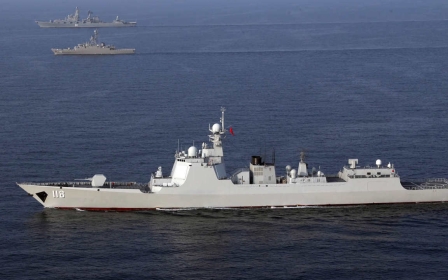US military posts then removes photos of bomb designed to target underground bunkers

The US military posted, then abruptly removed, photographs of a "bunker busting" bomb that can be used to target nuclear facilities, following concerns that the images revealed sensitive information about the weapon’s payload, according to weapons analysts that spoke to the Associated Press.
On 2 May, photographs of the GBU-57 bomb, known as a "Massive Ordnance Penetrator", appeared on the Facebook page of the Whiteman US Air Force Base in Missouri. The base is home to a fleet of B-2 stealth bombers, the only aircraft that can deploy the bomb.
The photo comes amid heightened tensions between Iran and the US. Talks aimed at reviving the 2015 nuclear deal have all but collapsed, while Iran’s military support for Russia’s war in Ukraine has further poisoned the relationship.
On Monday, the Associated Press reported that Tehran is building a nuclear facility deep in the Zagros Mountain range in Central Iran that is likely beyond the range of the GBU-57, which analysts say is Washington’s final option to knock out underground bunkers.
The US developed the Massive Ordnance Penetrator in the 2000s, with an eye towards Iran’s expanding nuclear programme.
New MEE newsletter: Jerusalem Dispatch
Sign up to get the latest insights and analysis on Israel-Palestine, alongside Turkey Unpacked and other MEE newsletters
The US has released images of the GBU-57 in the past, including in 2019, when air force showcased a video of the bomb being dropped from a B-2 bomber. The clip appeared following the Trump administration’s move to unilaterally withdraw from the nuclear deal and reimpose debilitating sanctions on Iran.
The Warzone first reported images that show US service members inspecting the bombs on a flatbed truck earlier this month. The photographs capture stenciling on a bomb that lists its weight as 12,300 kilograms and describes it as carrying a mix of AFX-757, a standard explosive, and PBXN-114, a relatively new explosive compound.
Explosives comprise only 20 percent of the bomb's weight, according to the Warzone. The rest comes from its dense, steel structure that allows it to tunnel deep into the earth and hidden bunkers.
The US deployed a similar bomb in 2017 when it launched the GBU-43B Massive Ordnance Air Blast bomb against Islamic State militants in Afghanistan. That weapon, dubbed the "Mother Of All Bombs", is so large that it is launched via an MC-130 transport plane and has a blast yield equivalent to 11 tonnes of TNT.
The US previously described the GBU-57 as capable of hitting targets through 60 metres of ground and cement before detonating. According to the Associated Press, the excavation mounds near the Natanz nuclear site suggest the facility could be between 80 metres and 100 metres underground.
Last week, Axios reported that the US has asked Israel to engage in joint military planning against Iran, offering a proposal that US officials have described as "unprecedented" as a means of boosting bilateral military cooperation.
Israel, which campaigned heavily against the 2015 nuclear deal, has been ramping up its attacks on nuclear sites and scientists inside Iran. Last summer, a number of Iranian officials and scientists were killed in Iran, including a senior member of the Revolutionary Guard's Quds Force who was assassinated in Tehran in broad daylight.
Middle East Eye delivers independent and unrivalled coverage and analysis of the Middle East, North Africa and beyond. To learn more about republishing this content and the associated fees, please fill out this form. More about MEE can be found here.




